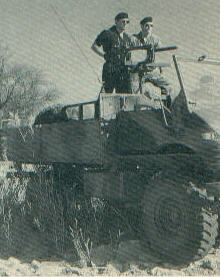Introduction
The Rhodesian Armoured Car Regiment (RAC) was originally raised in February 1941 for service in WWII. Later being disbanded and re-established in 1972 as the Rhodesian Armoured Corps (RAC) to combat Marxist terrorist in Rhodesia’s insurgency conflict as an armoured cavalry unit. The RAC represents a unit of approximately regimental size along with a Armoured car training center. During this time the unit received this unofficial nickname; “Black Devils” from the enemy, because of the distinctive all black jumpsuits worn by the regiment. This uniform was authorized by the regimental commander to give the elite outfit a unique look.
|
|||||||||||||||||||||||||||||||||||||
Mission
The primary function of RAC was as a rapid reaction /deployment
contingent, with a secondary mission in security operations and
supporting roles in reconnaissance, patrolling, escort duty, crowd
control, and roadblocks.
|
|||||||||||||||||||||||||||||||||||||
|
Structure and Equipment The Black Devils organizational structure is loosely comparable to western armored cavalry units. The Corps consists of four operational armoured squadrons (roughly regimental size), which in turn have four troops. Three of the squadrons were commanded by a cadre of regular officers and non-commissioned officers, and manned by territorials who were activated for incremental periods. The fourth squadron was manned as a regular establishment. The Black Devils maintained a pool of armoured vehicles of the wheeled variant all of foreign manufacture, with the exception of a couple. The majority of these vehicles were four-wheel drive, with various mounted armament of machine guns; either a 50 caliber machine gun, twin Brownings or a 20mm aircraft gun. The Rhodesians manufactured two additional combat vehicles. The Bullet was a wheeled infantry-fighting vehicle. It carried a 10-man crew. The vehicle commander was also the squad leader. The second was the Vaporizer, so named because if it were to hit a landmine it would vaporize. It was a high-speed dune buggy type vehicle used in the scout/reconnaissance role. This is a good example of the unit’s ingenuity; it was built upon a light chassis with a fiberglass body. It was manufactured for less than $1500, and mounted with a 30 or 50 caliber machine gun.
|
|||||||||||||||||||||||||||||||||||||
Tactic and Techniques
The tactics initially used by the RAC reflect its British heritage, and the United Kingdom’s association with NATO. However, as the war progressed, the RAC began to experiment with a blend of tactics incorporated from German, South Africa, French, and American. The Rhodesians studied these tactics, and modified them to the terrain and character of an African insurgency. The Black Devils employed tactic that fell into two major categories: · Tactics against ground troops with possible anti-tank capability. · Tactics against Conventional type Armour thrust The armour column always moved with the supported mechanized infantry, with one of the elements of combined arms in support. Air support was used only when absolutely essential. In order to compensate for the lack of an “aerial umbrella”, the armoured car units developed a tactical doctrine which emphasized:
|
|||||||||||||||||||||||||||||||||||||
Selection and Training
|
|||||||||||||||||||||||||||||||||||||
|
Conclusion Although the Rhodesian Armoured Corp was small and virtually self-reliant, it was a potent force which included an anti-armour capability. The Rhodesians never possessed tanks, but they had modified a number of their vehicles to carry anti-armour weapons. Throughout 1978-1979 they became justifiably concerned over the introduction of approximately 200 T-34, T-54 and T-62 Soviet tanks into Zambia accompanied by Cuban military advisors. With the introduction of this force into one of the Frontline Nations, Rhodesia received considerable assistance in upgrading its anti-armour capability from South Africa and possibly Israel. It has been impossible to define the exact nature of its anti-armour capacity, but both Jane’s and World Armies speculate upon the existence of a credible deterrent. The Black Devils have been reported to achieve contact with insurgent forces in excess of 90% of all their performed operations. This was impressive, but should be tempered with the knowledge that a squadron was never committed until military intelligence had established a large concentration of guerrilla forces. This was due to growing economical restraints, and it became imperative for the Black Devils to monitor cost factors and economy of force of all operations, to get the best and biggest bang for the buck.
|
|||||||||||||||||||||||||||||||||||||
|
Bibliography
|
|||||||||||||||||||||||||||||||||||||
 BRIEF
LINEAGE
BRIEF
LINEAGE






 RHODESIAN
CROCODILE
RHODESIAN
CROCODILE




 The
Rhodesian Armoured Corps (RAC) troopers are
issued black jump suits after successful completion of
training. Nicknamed Black Devils By a terrorist radio
station in Maputo, Mozambique, after a highly successful
raid.
The
Rhodesian Armoured Corps (RAC) troopers are
issued black jump suits after successful completion of
training. Nicknamed Black Devils By a terrorist radio
station in Maputo, Mozambique, after a highly successful
raid.

